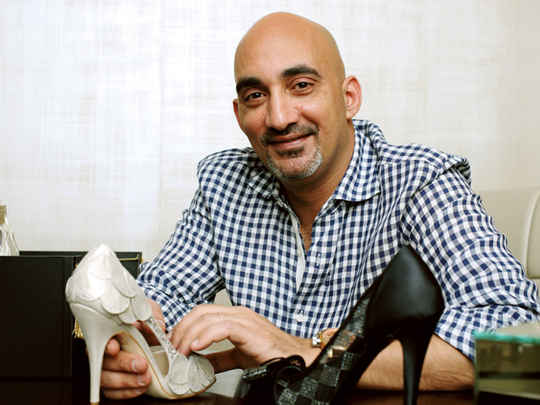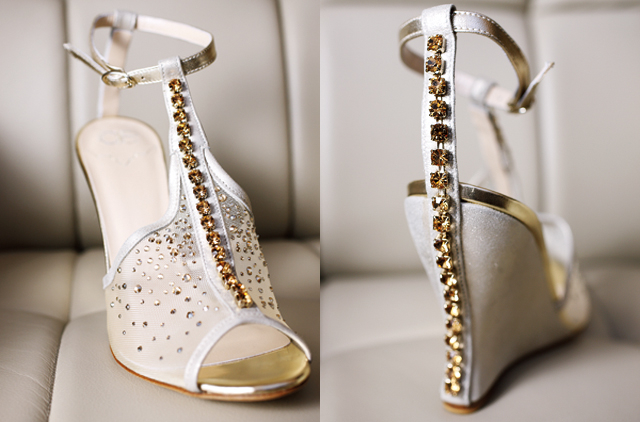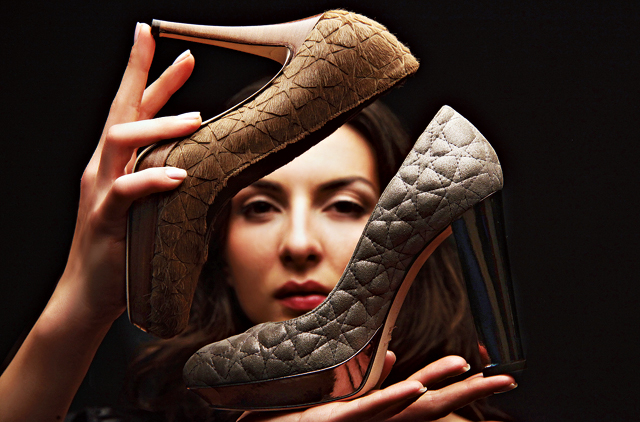
Anas Younis Shanaah may be the new hot-shot shoe designer on the block, but there's nothing flashy about him. Unlike several others of his ilk, he doesn't sport any crazy bling to indicate his status or drop names of celebrities who sport his designs. But is it true that actress Monica Bellucci wears his designs? "Well, she certainly has them though I don't know if she wears them!" says the 42-year-old, during the recent launch of his shoe collection at Bloomingdale's at The Dubai Mall.
Anas' brand, aennis eunis, has been creating a buzz since he launched it in 2009. He's known in fashion circles as the designer behind a new line of "must-have" shoes and accessories that fuse the traditional heritage of the Arabian world with a modern twist.
Anas is a whiz at creating footwear that is playful, decadent and has "nods to Arabic culture", as he puts it. That should be expected from a person who spent more than 15 years studying the shoe industry in Florence before opening his own store in New York.
After graduating with a degree in architecture in Amman in 1992, he worked with leather experts in Italy, before studying industrial design in America. "Architecture was my training, but my real passion was industrial design, which I chose as the subject for my Masters," he says. "My thesis subject was on display systems for retail businesses. I entered the retail world from a design and display perspective and went on to open my own store selling footwear and handbags.
"I used to buy shoes, modify them and sell them," he adds. "I'd take a shoe, change the colour, add a heel or take it off, you know that kind of mix and match. The shoe manufacturer wouldn't mind as long as you're purchasing them. Unless I loved the original shoe, I would change them according to my liking.
"As I got to see what customers liked and didn't like, I started understanding the footwear industry - what I could change and what I couldn't. And that's what got me hooked," he says.
Akin to architecture
There's a reason why Anas chose to design shoes. "They're the closest thing I can find to architecture," he explains. "Fabrics, I don't know much about. But when you look at a shoe, it's a volume, it's a sculptural piece, it has a structure. There are 76 different components that go into a shoe. There's a lot of learning in terms of the industry and mechanics, which I like.
"I also like to display them. When I used to design display systems I always used to do them for shoes. They are three dimensional, while cloth for me is two dimensional."
Even though his brand is now global, Anas doesn't have any ego - probably because he doesn't look at himself as a fashion designer. "I look at shoes more like a product, as a piece of sculpture," he explains.
"I don't approach a design problem as any fashion designer would because my training is in architecture and industrial design. I challenge the rules in the manufacture of shoes because I didn't study fashion. I probably do it in a way most fashion designers were taught not to do it! So we're pushing the envelope in a way," Anas says.
His approach to design is unique. "I start conceptually. It's not only about a beautiful line. There has to be a story behind every collection. When we did the shoes based on Arabic calligraphy, the letters actually created the shoe for us, it wasn't slapped on. We actually built the shoes through the letters," he says. "The next collection was about Damascus fabric - displaying the fabric with blocks of colours that had a nice feminine line."
Sometimes the materials he's working with are the impetus for the shoe's design. "I might say, ‘this season it's all about manipulating leather'. So we'll take the leather, twist it, turn it, do a knot here, pinch it there, play with the leather, come up with a formula and apply it to the shoes," he explains.
"So there's always an angle from where we start. The references are the flavour, the spices that give the collection some kind of identity, but it's not just about them. We still want to design beautiful shoes that are modern, trendy and that if you put them next to any other brand, they will still stand out."
The calligraphy collection is a celebration of the fluid lines of Arabic lettering designed to add a sophisticated, yet mystical flavour with timeless works of art. "The choice of exquisite leather along with the fine Italian craftsmanship turns each pair of shoes into a masterpiece," he says.
Although Anas introduced Middle Eastern elements into his line, he's open to using references from other cultures too. "There will always be some cultural references in my designs, I am sure, though it may not always be Middle Eastern," he says. "I might go with my team to India or China or wherever and study the culture there or find an angle and use it. Right now I have a lot to tap in the Middle Eastern culture."
Fairytale shoes
For the 1001 Nights collection, Anas turned to the familiar treasure chest of Arabic fairytales. "We selected seven characters from the 1001 Nights tales and studied them, the stories behind them, any descriptions given, and from all that information we started the design process," he says. "We didn't just slap ‘1001 Nights' on the collection just because we wanted to put some stones on it and call it something fancy," Anas adds. "We studied the characters and every shoe has some of the ingredients of the book, and the design is related to the story or the character behind it."
There's the Scheherazade design, named after the heroine of 1001 Nights, Scheherazade, who narrates the 1001 tales to Caliph Shahryar, saving the maidens in the kingdom. "She's the most famous, of course, and you can tell from the design of the footwear there's a soft part and a hard part, which is a combination of her character being feminine and sweet, but at the same time she was very wise, and survived the wrath of Shahryar by telling him stories every night," explains Anas. The Jawharah Al Bihar design is based on a mermaid princess character. Hearing descriptions of her beauty, King Bader was so fascinated that he filled a sack full of rubies and emeralds and marched off to find her. He found her atop a tree and had to woo the bashful princess to climb down.
"The delicate embellished layers on the shoe that appear to flow from under one another depict Jawharah Al Bihar's bashfulness, magnificent beauty and elegance," explains Anas. A striking strip of embossed crystals is swept across the side of the design to bring together the front and back of the form, gracefully illustrating the journey from the high tree top to the ground, where love was celebrated.
This collection is available only through special order and is priced between €750 and €1,200 (Dh3,560 and 5,699). The reason is the kind of workmanship the shoes require. They will be delivered in four to six weeks. The 1001 Nights collection will be available later this year. Until then they will be available exclusively through special order.
"Everything in my collection is made in Italy," says Anas. "With the kind of complexity of work only the truly professional masters can do - handbags, shoes, etc. We deal with more than one factory in Italy. We have a good base there. Our design and marketing office is in Jordan, so we split our time between the countries."
Anas left the US to return to Jordan three years ago. "It is where I get my references," he says. "I can walk downtown and get ideas. That's why I need to be based here in the Middle East - it's good for my creativity."
But he plans to go back to New York in future and this time he'll go with his own brand - of which he's already immensely proud.













